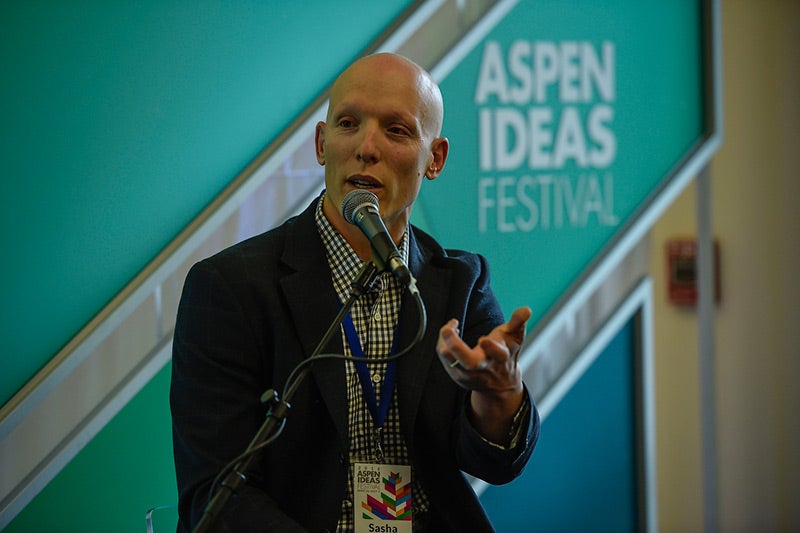
Sasha Dichter, chief innovation officer for Acumen, at the 2016 Aspen Ideas Festival (Photo Credit: Riccardo Savi/The Aspen Institute)
Sasha Dichter is chief innovation officer for Acumen, a nonprofit that raises donations to invest in tackling poverty. He spoke at the Aspen Ideas Festival on July 1st, on a panel called “What Happens When Brilliant Entrepreneurs Turn Their Minds to Social Challenges?”
Below, Dichter explains how new technology is making impact investors’ work more effective by incorporating more voices from the communities they serve.
In 2006, Sam Goldman and Ned Tozun set out to eradicate kerosene as a source of light in the developing world. As a Peace Corps volunteer in Benin, Sam witnessed the damage kerosene could do when an overturned lantern created a fire that nearly killed his neighbor’s son. They also saw what a scourge the dirty fuel was for poor, rural families without access to energy, eating up 15 percent of their spending.
Sam and Ned decided to start d.light design, a social enterprise that would solve this problem once and for all. With funding from Acumen and others, d.light set out to create a business providing low-cost solar lanterns to poor customers. Since then, the company has sold tens of millions of solar-powered lights across more than 40 countries.
So is d.light a success? By one measure, absolutely. They are seeing demand for their product, growing revenues, and are on track to reach 100 million customers by 2020. That’s nearly 10 percent of the more than 1.3 billion people globally without access to electricity. But for entrepreneurs like Sam and Ned — and all of us at Acumen with a mission to make a real dent in poverty — just reaching a large number of people isn’t good enough.
At Acumen, we’ve spent the last 15 years investing in social enterprises that provide critical goods and services to the poor. We invest in these businesses because they are hard-wired to reach large numbers of people: when a social enterprise gets its model right, it will reach more people per dollar funded than traditional aid or philanthropy.
But while it makes us proud to say we’ve helped millions of people acquire a reliable solar light, we need more than just big numbers to tell us if we are actually changing people’s lives.
How can we know if we are making a real difference?
You’d assume impact investors must be good at measuring social impact. How else could we call ourselves “impact” investors? Not surprisingly, 95 percent of impact investors say they measure impact . But, if you scratch the surface, you’ll discover that current definitions of impact are mostly limited to big, flashy numbers: number of farmers using an improved kind of seed, number of kids attending school, or, as in the case of d.light, number of lights sold.
This is a start, but it’s not good enough. Typical impact investors may know how many farmers a company has reached, but they don’t have a clue if these farmers are better off. They may know how many kids attend schools, but they can’t tell you if the students are from low-income communities or just transplants from the private school down the street. They may know how many households bought a new solar lantern, but they don’t understand if the children in these homes are still dying from kerosene fires.
There’s a good reason impact investors have been falling short — the existing tools for measuring social impact are nearly useless to a social entrepreneur.
The good news is, we have an opportunity to change this, thanks to the technological revolution that is finally achieving global reach. Today there are more than 7 billion mobile subscribers globally, 5.5 billion of whom live in the developing world. In sub-Saharan Africa alone, the number of mobile subscribers will grow from 600 million today to 930 million by 2020. Even more exciting, by 2020 nearly half of the world’s 6.1 billion smartphone users will live in the developing world. This explosion in mobile penetration means that we now have the ability to hear from the poorest customers in the world and incorporate their voices in new ways.
At Acumen, we’ve developed a new approach to impact measurement that takes advantage of this shift. Our approach is optimized for entrepreneurs building social enterprises in the developing world, and it capitalizes on today’s information revolution to gather data directly from low-income customers. Our goal is to use this infrastructure to understand our social impact and better serve the poor. We call this approach Lean Data.
Lean Data revolutionizes traditional measurement techniques in international development by cutting the costs of collecting data by up to 100 times and decreasing collection time from years to weeks or even days. In the last year, we’ve completed Lean Data projects with over 30 of our companies and gathered data from more than 10,000 low-income customers — primarily through questions via mobile phones. Unlike traditional impact measurement, these projects are fast, inexpensive, and they give insights that an entrepreneur can use right away.
For example, SolarNow, a solar home system company in Uganda, heard from customers that, above increased hours of light or better quality of light, what mattered most to them was the money they saved by owning a solar home system. Based on this feedback, the company reframed and tightened their marketing message, and is increasingly focused on gathering better data on how much customers save by owning these systems. To do this, SolarNow is partnering with Acumen to bring Lean Data in-house by building a Customer Insight team to regularly gather customer data even from their hardest-to-reach customers.
This sort of quick shift in business practices based on customer feedback around impact is all too rare in the social sector. This isn’t surprising because, while the social sector has historically collected a lot of data around social impact, these efforts are designed to meet the needs of donors, investors, or academics. What we believe is missing is data collection designed from the outset to deliver value for companies and, even more importantly, for the customers they serve.
We hope that Lean Data starts to fill this gap, allowing us to orient differently to the millions of new customers who are just entering the modern economy, both as producers in global supply chains, and as consumers of products that meet their most basic needs at qualities and price points that would have been unimaginable just 10 years ago. Our opportunity, beyond extending the market to these customers, is to ensure that, from the outset, we create mechanisms that allow them to have their voices heard about how they want to participate in the global economy.
By giving more entrepreneurs like Sam and Ned the right tools to understand their social impact and hear from their customers, they will, for the first time, have actionable data that can tell them, in real time, how to improve their products and create meaningful change. If we do this right, we can leverage the spread of technology to listen to billions of previously unheard consumers, and, in so doing, we can build solutions that address the root causes of poverty from the ground up.
It’s time to move beyond the big, glossy numbers that allow us to sing our own praises, and to raise more money, but that do little to help us improve the lives of the people we aim to serve. It’s time to use technology to talk directly to our customers, so that our work can realize its full potential.

